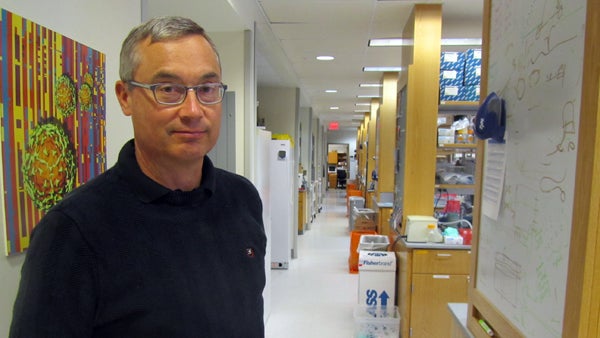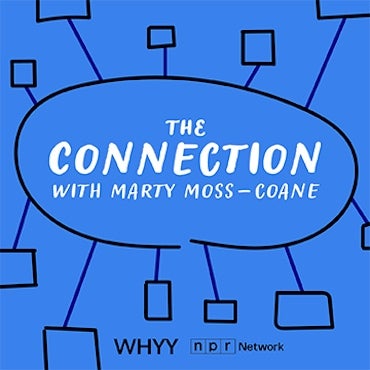Penn scientist seeks clues about the viruses in your gut

Rick Bushman is a microbiologist at the University of Pennsylvania studying the human microbiome in hopes of better understanding the role of microbes in human health. (Elana Gordon/WHYY)
The human race is about seven billion strong and growing, but the microbes that exist within the gut of even just one individual far surpass that number. In fact, the bacteria that make up your microbiome, as it’s often called, outnumber your own human cells.
“There are way more of them than us,” said Rick Bushman, a microbiologist at the University of Pennsylvania. Bushman is part of a recent wave of scientists studying these microbial communities, in hopes of better understanding their role in human health.
“Sometimes the bugs that live in us make us sick, like an HIV infection or something like that,” said Bushman. “However … the bugs that live in our gut help us digest food and help instruct the growth of our immune system.”
You’ve got a virus. Billions of them, actually.
And Bushman isn’t stopping there. Inside those bacterial cells exists an even smaller, but no less dynamic community. Welcome to the world of viruses, or your “virome.” Healthy or not, everyone’s got them.
Lots of them.
“Hands down, there are way more viruses than there are bacteria,” he said. One gram of poop, for example, contains about a 100 billion viruses, making them in Bushman’s mind “the all-time champs.”
But unlike bacteria or other cells, viruses can’t live on their own. They latch on to host cells to function. Once there, a virus may do a number of things. Some have integrated into people’s DNA, explained Bushman, and are part of that essential genetic material that makes us who we are, telling our cells what to do and how to act.
“The human genome is 8 percent virus,” said Bushman. “They’re part of us.”
One example Bushman gave is the role these viruses play in the development of a human placenta.
Viruses can also be ruthless predators. Once inside, they may replicate to the point of destroying their host cell, then moving on to the next one, wreaking havoc in the same way. In other instances, Bushman explained, viruses insert themselves in bacteria but stay put, replicating when the bacteria itself replicates.
“Sometimes they harm, sometimes they help,” Bushman said.
In some instances, viruses may aid in the digestion of carbohydrates. In others, they may carry harmful toxins such as cholera
Research limitations
For more than a century, scientists have turned to viruses to understand how molecules work.
“A lot of the early days of molecular biology involved studying bacterial systems, purifying one virus and seeing how it interacts,” Bushman said. Scientists have long recognized that some gut diseases are viral.
Up until recently, scientists lacked the capacity to extract and study whole virus systems at once, with the volume of data too vast to process. Bushman said that has limited what’s known about the nature and scope of how these little microbes act as a community. But thanks to the advent of genetic sequencing technology, he and others are now able to sift through billions of bits of sequenced genetic material – material, for example, that can be derived from one tiny ounce of, well, poop.
Bushman’s lab began its study of the human virome by examining fecal samples from several individuals, identifying and comparing viruses from each of their guts.
“People [and their viral communities] were really different from each other,” Bushman recalled from that study. His findings echo what other researchers are learning in the field.
“And the obvious question was: Why is that? What’s going on long term inside one person?”
This led to Bushman’s next experiment, recently published in the Proceedings of the National Academy of Sciences. His team took one person — a healthy male — and tracked the virus activity in his gut over the course of two and a half years.
“The community is so huge inside that one person, it’s like studying a rain forest,” Bushman said.
Steady but evolving
It took Bushman’s lab another year to analyze the genetic data from a mere 16 stool samples. After going through a refrigerator-like sequencing machine (located two buildings over), the lab ran computer programs on the data, trying to identify small virus segments and piece them together.
Two things stood out, he said. First, the majority of bacteria viruses he identified inside the individual’s gut at the start of the study were still there at the end of the study.
“So that was important to know that the community was mostly stable,” Bushman said. “Which then allowed us to start in on a whole new round of experiments, asking OK, against this background of being able to see this same virus over two and a half years, what more specific stuff could we see changing in those viruses?”
And, it turned out, a small portion of those viruses was far from static.
“For some of the viruses that are there, they’re changing really, really fast. So in a lifetime of an average human, it seems that new kinds of viruses are going to be arising and living in their gut,” Bushman said. “And in their gut only.”
Health implications
Though still in the early stages of calculations, Bushman thinks about 5 percent of viruses evolve into new viruses, over time in an indivdidual’s gut. In other words, what’s in your gut is unique, in part because it contains different bacteria, which contain different viruses, that evolve over time.
This notion, Bushman said, opens the door to a whole new set of questions: What proportion of bacteria is killed each day by viruses? How do those bacteria continue to exist and survive?
The challenge now is learning more about how that might affect diseases, such as Crohn’s, and individual treatments.
WHYY is your source for fact-based, in-depth journalism and information. As a nonprofit organization, we rely on financial support from readers like you. Please give today.

